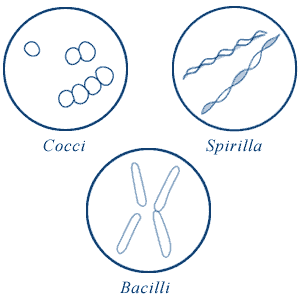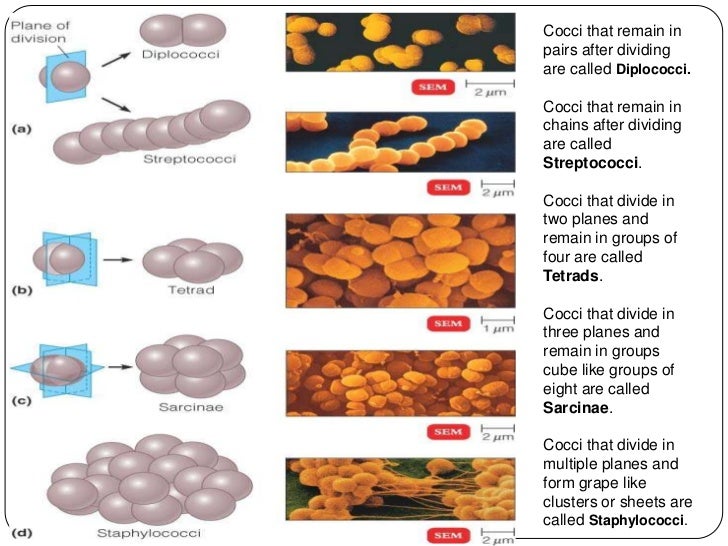
Microorganisms or microbes, which may exist in its single celled form, or in colony of cells.
The existence of microscopic organisms was
discovered during the period 1665-83 by two
Fellows of The Royal Society, Robert Hooke and
Antoni van Leeuwenhoek. In Micrographia
(1665), Hooke presented the first published
depiction of a microoganism, the
microfungusMucor. Later, Leeuwenhoek was
1st to observed micro organism under pound of
water and described microscopic protozoa and
bacteria.
5 Types of Microbes

Bacteria a unicellular organisms. The cells
are described as prokaryotic because they
lack a nucleus. According to the way their
cell wall structure stains, bacteria can be
classified as either Gram-positive or Gram-
negative when using the Gram staining.
According to the way they obtain energy,
bacteria are classified as heterotrophs or
autotrophs. Autotrophs make their own food by using the energy of sunlight or chemical reactions. Heterotrophs obtain their energy by consuming other organisms. Bacteria that use decaying life forms as a source of energy are called saprophytes.

Archaea or Archaebacteria differ from true bacteria in their cell wall structure and lack peptidoglycans. They are prokaryotic cells with avidity to extreme environmental conditions

Fungi (mushroom, molds, and yeasts) are eukaryotic cells (with a true nucleus). Most fungi are multicellular and their cell wall is composed of chitin. They obtain nutrients by absorbing organic material from their environment (decomposers), through symbiotic relationships with plants (symbionts), or harmful relationships with a host (parasites). Fungi reproduce by releasing spores.
Protozoa are unicellular aerobic eukaryotes. They have a nucleus, complex organelles, and obtain nourishment by absorption or ingestion through specialized structures. They make up the largest group of organisms in the world in terms of numbers, biomass, and diversity. Their cell walls are made up of cellulose.

Algae, also called cyanobacteria or blue-green algae, are unicellular or multicellular eukaryotes that obtain nourishment by photosynthesis. They live in water, damp soil, and rocks and produce oxygen and carbohydrates used by other organisms. It is believed that cyanobacteria are the origins of green land plants.

Viruses are noncellular entities that consist of a nucleic acid core (DNA or RNA) surrounded by a protein coat. Although viruses are classified as microorganisms, they are not considered living organisms. Viruses cannot reproduce outside a host cell and cannot metabolize on their own. Viruses often infest prokaryotic and eukaryotic cells causing diseases.
Types of Bacterial Shapes
Due to the presence of a rigid cell wall, bacteria maintain a definite shape, though they vary as shape, size and structure. The three basic bacterial shapes are coccus (spherical), bacillus (rod-shaped), and spiral (twisted), however pleomorphic bacteria can assume several shapes.

Cocci (or coccus for a single cell) are round cells,
sometimes slightly flattened when they are
adjacent to one another.
Bacilli (or bacillus for a single cell) are rod-shaped
bacteria.
Spirilla (or spirillum for a single cell) are curved
bacteria which can range from a gently curved shape to a corkscrew-like spiral. Many spirilla are rigid and capable of movement. A special group of spirilla known as spirochetes are long, slender, and flexible.
Arrangement of Cocci
Cocci bacteria can exist singly, in pairs (as diplococci ), in groups of four (as tetrads ), in chains (as streptococci ), in clusters (as stapylococci ), or in cubes consisting of eight cells (as sarcinae). Cocci may be oval, elongated, or flattened on one side. Cocci may remain attached after cell division. These group characteristics are often used to help identify certain cocci.
- Diplococci
The cocci are arranged in pairs.
Examples: Streptococcus pneumoniae, Moraxella catarrhalis, Neisseria gonorrhoeae, etc

- Streptococci
The cocci are arranged in chains, as the cells divide in one plane.
Examples: Streptococcus pyogenes, Streptococcus agalactiae
- Tetrads
The cocci are arranged in packets of four cells, as the cells divide in two plains.
Examples: Aerococcus, Pediococcus and Tetragenococcus
- Sarcinae
The cocci are arranged in a cuboidal manner, as the cells are formed by regular cell divisions in three planes. Cocci that divide in three planes and remain in groups cube like groups of eight.
Examples: Sarcinaventriculi, Sarcinaureae, etc.
- Staphylococci
The cocci are arranged in grape-like clusters formed by irregular cell divisions in three plains.
Examples: Staphylococcus aureus
Arrangement of Bacilli

The cylindrical or rod-shaped bacteria are called ‘bacillus’ (plural: bacilli).
- Diplobacilli
Most bacilli appear as single rods. Diplobacilli appear in pairs after division.
Example of Single Rod: Bacillus cereus
Examples of Diplobacilli: Coxiellaburnetii, Moraxella bovis, Klebsiellarhinoscleromatis, etc.
- Streptobacilli
The bacilli are arranged in chains, as the cells divide in one plane.
Examples: Streptobacillusmoniliformis
- Coccobacilli These are so short and stumpy that they appear ovoid. They look like coccus and bacillus.Examples: Haemophilusinfluenzae, Gardnerellavaginalis, and Chlamydia trachomatis
- Palisades
The bacilli bend at the points of division following the cell divisions, resulting in a palisade arrangement resembling a picket fence and angular patterns that look like Chinese letters.
Example: Corynebacteriumdiphtheriae
Arrangement of Spiral Bacteria
 Spirilla (or spirillum for a single cell) are curved bacteria which can range from a gently curved shape to a corkscrew-like spiral. Many spirilla are rigid and capable of movement. A special group of spirilla known as spirochetes are long, slender, and flexible.
Spirilla (or spirillum for a single cell) are curved bacteria which can range from a gently curved shape to a corkscrew-like spiral. Many spirilla are rigid and capable of movement. A special group of spirilla known as spirochetes are long, slender, and flexible.
- Vibrio
They are comma-shaped bacteria with less than one complete turn or twist in the cell.
Example: Vibrio cholerae
- Spirilla
They have rigid spiral structure. Spirillum with many turns can superficially resemble spirochetes. They do not have outer sheath and endoflagella, but have typical bacterial flagella.
Example: Campylobacter jejuni, Helicobacter pylori, Spirillum winogradskyi, etc.
- Spirochetes
Spirochetes have a helical shape and flexible bodies. Spirochetes move by means of axial filaments, which look like flagella contained beneath a flexible external sheath but lack typical bacterial flagella.
Examples: Leptospira species (Leptospirainterrogans), Treponema pallidum, Borreliarecurrentis, etc.
Bacteria can help or harm. They can make us sick or neutralize viruses that are attacking our bodies. Friendly bacteria produce antibodies and are found on our skin and in our digestive tracts. Bacteria have been cultivated for many beneficial uses, from medicine to biotechnology.
Benefits of Bacteria on the Environment
Uses in Medicine
Bacteria are used to produce vaccines, antibiotics and other drugs that fight infections. Antibiotics kill or inhibit the growth of bacteria. Although antibiotics are not effective against viral infections, such as the common cold, some bacteria have been discovered that can help resist viruses. Vaccines are designed to help the body’s immune system fight diseases.
Beneficial Bacteria in Food
We come into contact with a lot of bacteria through the food we eat. Bacteria are used to make products like bread, beer and cheese. It is possible these bacteria not only make food taste good, but also are good for us. Probiotics is a process in which friendly bacteria are added to foods like yogurt and chocolate.
Benefits to the Body
The human body contains 10 times more bacteria than cells. Bacteria help the body with functions like digestion, immunity and keeping potentially harmfulbacteria like E. coli from making us sick. Bacteria helps synthesize vitamins like biotin, vitamin K and folic acid.
Biotechnology
Biotechnology is a branch of science that uses bacteria and other microorganisms. This field has recreated helpful substances found in the body, like growth hormones and human insulin. Biotechnology also is used in agriculture. Specially mutated forms of bacteria have been introduced to soil as a way to make it more fertile.
Examples of Microbial Infections and Its Causative Agents

AIDS (Acquired immunodeficiency syndrome) is a spectrum of conditions caused by infection with the human immunodeficiency virus (HIV).

Chickenpox, also known as varicella, is a highly contagious disease caused by the initial infection with varicella zoster virus
Dengue fever is a mosquito-borne tropical disease caused by the dengue virus.

Bacteria are everywhere. They are responsible for the basic functions of the environment. They break down dead plants and animals, and make nutrients for other living things. Some plants store bacteria in their roots to break down nutrients in the soil.
If there are good microbes there are also bad that can cause microbial infection
